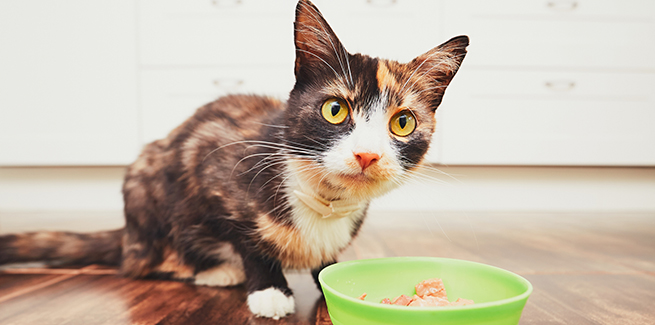Once-per-day feedings could improve feline health

Feeding cats more often might actually make them hungrier.
Animal nutrition specialists in the University of Guelph’s Ontario Veterinary College (OVC) and Ontario Agricultural College have found that feeding cats one large meal per day may help control hunger better than feeding them several times throughout the day.
The research, published earlier this month in the journal PLOS One, revealed that cats who ate one meal per day were more satisfied, which could result in less food-begging behavior.
The results also suggest that cutting back feeding frequency could help reduce the risk of obesity by controlling cats’ appetites and potentially making them eat less—an important discovery, given that obesity is the most common nutritional problem affecting cats.
Coauthor Adronie Verbrugghe, DVM, PhD, DECVCN, assistant professor, and chair of Canine and Feline Clinical Nutrition at OVC, told NEWStat that their research indicated that three key satiety hormones were higher after cats ate one meal than after eating four meals. “The increase of these hormones may indicate that cats were more satiated,” Verbrugghe said, adding that appetite and satiety regulation is very complicated: “The gut-brain axis controls appetite and satiety via neuronal and hormonal signals. One aspect of this regulation is that the entry of nutrients in the small intestine stimulates the release of peptides—such as the three hormones, GIP, GLP-1, and PYY, that [showed an increase] in our study.” The release of these peptides acts as a negative feedback signal, causing the cat to eat less or even stop eating.
Verbrugghe said that, based on their research, feeding cats just one meal per day could:
- Increase satiety, as three key satiety hormones increased
- Help burn fat and therefore prevent weight gain, as the respiratory quotient was lower
- Increase protein synthesis and thereby help maintain or build muscle mass, as plasma amino acids were higher after one meal versus four meals
Verbrugghe said that, in contrast to previous research on the effect of meal frequency on cats, her team used a more comprehensive approach: “Previous research has looked at activity and some satiety hormones. In our study, we also looked at activity and the same hormones to confirm previous findings, but we then added more hormones, indirect calorimetry, and postprandial 24-hour glucose and amino acid curves.”
“These findings may surprise the veterinary community and many cat owners who have been told their animals need several small meals a day,” Verbrugghe said.
She says that mindset about multiple meals exists for a number of reasons: “Multiple small meals are perceived as more natural for cats. It’s been shown that wild cats have to eat 10 to 20 small prey per day to keep up with their energy needs.” However, there are also bigger cats, like lions, who hunt for larger prey and eat only occasionally. “Another reason for feeding multiple small meals is more behavioral, to keep our cats busy during the day and to prevent them from asking us for food all the time.”
And there are also less scientific reasons for feeding cats multiple meals: “Feeding is often associated with showing love for our pets.”
Photo credit: © Gettyimages/Chalabala



